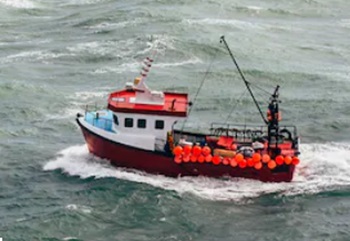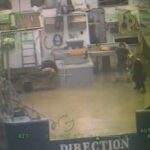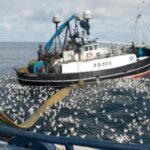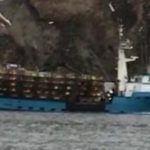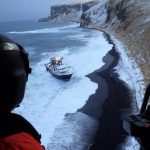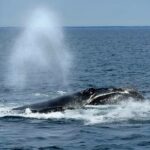Tag Archives: Global Fishing Watch
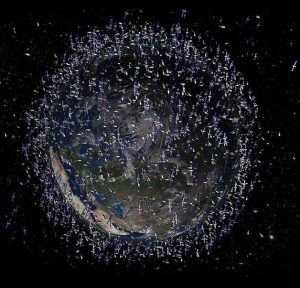
We’ve surrounded the Earth with surveillance satellites, but who is that good for?
It is no longer just advanced militaries and rich corporations who can keep tabs on what people are up to half a world away. Watchdogs such as Global Forest Watch, Global Fishing Watch, and SkyTruth are combing through satellite photos and radar scans to alert authorities to illegal clear-cutting, rogue fishing, mountaintop removals, and other environmental misbehavior. Researchers at the Cornell Lab of Ornithology have exploited Amazon cloud servers to assemble millions of amateur birdwatcher reports into exquisite animated maps that plot the changing abundance of 122 bird species throughout North America. Ranchers are stapling health-monitoring microchips to their livestock. Beekeepers are sticking wireless sensors into their hives. Farmers are planting high-tech electronics into the soil along with their crops. >click to read< 16:17
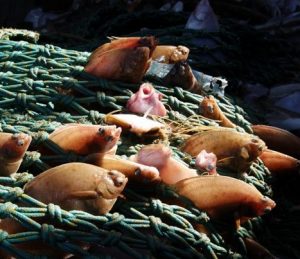
Wait, So How Much of the Ocean Is Actually Fished?
How much of the world’s oceans are affected by fishing? In February, a team of scientists led by David Kroodsma from the Global Fishing Watch published a paper that put the figure at 55 percent—an area four times larger than that covered by land-based agriculture. The paper was widely covered, with several outlets leading with the eye-popping stat that “half the world’s oceans [are] now fished industrially.” Ricardo Amoroso from the University of Washington had also been trying to track global fishing activity and when he saw the headlines, he felt that the 55 percent figure was wildly off. He and his colleagues re-analyzed the data that the Global Fishing Watch had made freely available. And in their own paper, published two weeks ago, they claim that industrial fishing occurs over just 4 percent of the ocean. How could two groups have produced such wildly different answers using the same set of data? >click to read<21:21

Ray Hilborn: New study provides no new information on global fishing footprint
University of Washington fisheries researcher Ray Hilborn said that a new study using satellite data from industrial fishing vessels to map global fishing effort fails to provide any new insight, despite media reports indicating otherwise. The study, published in Science in February, used messages transmitted between 2012 and 2016 from the automatic identification systems (AIS) of more than 70,000 industrial fishing vessels to create a global footprint, concluding that “industrial fishing occurs in over 55 percent of ocean area,” according to the abstract. But Hilborn said the vessels monitored for the study were in large part tuna boats over 100 feet, which have been monitored for decades. >click to read< 11:17

China, Spain, Taiwan, Japan and S Korea account for 85% global fishing efforts
The research, led by scientists at Global Fishing Watch, a research organization that uses satellite data to track fishing activity, examined some 22 billion ship-location data points for more than 70,000 industrial fishing vessels between 2012 and 2016. It found commercial fishing hotspots in the northeast Atlantic and northwest Pacific, as well as in nutrient-rich areas off the coasts of South America and West Africa. The study also found that fleets from just five countries — China, Spain, Taiwan, Japan, and South Korea — account for more than 85% of fishing efforts in the high seas. >click to read< 09:51

Study reveals fishing’s startling global footprint: co-author Boris Worm, ‘It totally blows me away’
Global fishing efforts are so wide ranging that fleets covered more than 460 million kilometres in 2016 — a distance equal to going to the moon and back 600 times. That startling revelation is contained in a newly published study in Science that quantifies fishing’s global footprint for the first time. “I’ve been working on fishing for 20 years and it totally blows me away,” co-author Boris Worm, a marine biologist at Dalhousie University in Halifax, said of the findings. The study — which included researchers from Global Fishing Watch, National Geographic, Google and U.S. universities such as Stanford — used satellite feeds and common ship tracking technology known as the automatic identification system (AIS). >click to read< 15:47 
The idea that “the public” will use Global Fishing Watch seems doubtful
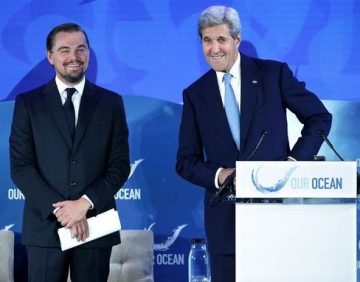 At John Kerry’s 2014 “Our Ocean” conference, a tuxedoed Leonardo DiCaprio introduced a new technology that promised to end illegal fishing across the globe. Global Fishing Watch boasted real-time monitoring of the world’s ships. This machine-learning spy tool was the result of a collaboration between the conservation advocacy organization Oceana, the satellite surveillance firm SkyTruth, and Google. After it collects and maps vessel location data transmitted from onboard satellite tracking devices, the program organizes all data points on a user-friendly Internet platform. For the first time in history, all fishing activity is recorded–even on the high seas that lie outside national jurisdictions. With Global Fishing Watch’s all-seeing gaze, states can adjudicate crimes to which they were previously blind. But the idea that “the public” will use Global Fishing Watch seems doubtful. The web platform lacks common features without which vigilantes would need a lot of training: pop-ups of helpful tips on what to watch for, alerts to specific hot-spots, built-in reporting mechanisms, or forums for users to share their experiences. Worse, those who the technology could most benefit–local fishers forced to compete with larger illegal ships–often do not have access to a decent Internet connection. If Global Fishing Watch is unlikely to be used by ordinary citizens of the countries most affected by illegal fishing, why is it marketed like a neighborhood watch tool? Read the story here 11:27
At John Kerry’s 2014 “Our Ocean” conference, a tuxedoed Leonardo DiCaprio introduced a new technology that promised to end illegal fishing across the globe. Global Fishing Watch boasted real-time monitoring of the world’s ships. This machine-learning spy tool was the result of a collaboration between the conservation advocacy organization Oceana, the satellite surveillance firm SkyTruth, and Google. After it collects and maps vessel location data transmitted from onboard satellite tracking devices, the program organizes all data points on a user-friendly Internet platform. For the first time in history, all fishing activity is recorded–even on the high seas that lie outside national jurisdictions. With Global Fishing Watch’s all-seeing gaze, states can adjudicate crimes to which they were previously blind. But the idea that “the public” will use Global Fishing Watch seems doubtful. The web platform lacks common features without which vigilantes would need a lot of training: pop-ups of helpful tips on what to watch for, alerts to specific hot-spots, built-in reporting mechanisms, or forums for users to share their experiences. Worse, those who the technology could most benefit–local fishers forced to compete with larger illegal ships–often do not have access to a decent Internet connection. If Global Fishing Watch is unlikely to be used by ordinary citizens of the countries most affected by illegal fishing, why is it marketed like a neighborhood watch tool? Read the story here 11:27
Hollywood Elitist Leonardo DiCaprio and Hollywood Elitist Oceana spy on fishing industry with “Global Fishing Watch”
 Thinking of poaching a protected reef? Big Data is watching you, with a little help from the “Wolf of Wall Street” and an ocean watchdog. And the new satellite-driven system already has snagged one commercial fishing company to the tune of $2 million. Academy award winning actor Leonardo DiCaprio is expected to announce Thursday the official launch of Oceana’s new free online interactive tool, called Global Fishing Watch, which last year helped nab a Marshall Islands-flagged vessel fishing illegally in a protected area. Now, anyone can go on www.globalfishingwatch.org to police the seas. Oceana hopes the new tool will help fishery managers to stop illegal fishing. Users can generate authorization lists to see who’s allowed to fish in certain areas. Nations can ensure only authorized vessels enter their Exclusive Economic Zone (EEZ), generally 200 nautical miles from a country’s coastline. Read the story here 09:05
Thinking of poaching a protected reef? Big Data is watching you, with a little help from the “Wolf of Wall Street” and an ocean watchdog. And the new satellite-driven system already has snagged one commercial fishing company to the tune of $2 million. Academy award winning actor Leonardo DiCaprio is expected to announce Thursday the official launch of Oceana’s new free online interactive tool, called Global Fishing Watch, which last year helped nab a Marshall Islands-flagged vessel fishing illegally in a protected area. Now, anyone can go on www.globalfishingwatch.org to police the seas. Oceana hopes the new tool will help fishery managers to stop illegal fishing. Users can generate authorization lists to see who’s allowed to fish in certain areas. Nations can ensure only authorized vessels enter their Exclusive Economic Zone (EEZ), generally 200 nautical miles from a country’s coastline. Read the story here 09:05
Global Fishing Watch: Google’s Big Data Overfishing Project Flounders
 Last month at the International Union for Conservation of Nature’s World Parks Congress in Sydney, Australia, Google unveiled a project it bills as a groundbreaking leap in the use of cloud computing, big data, and satellite networks—all to stamp out overfishing. The program, Global Fishing Watch, launched in beta with the help of environmental outfits Oceana and SkyTruth, uses the signals from Automatic Identification Systems (emergency devices installed in all major ships) to plot the trajectory of every commercial fishing vessel on the ocean. Read the rest here 21:45
Last month at the International Union for Conservation of Nature’s World Parks Congress in Sydney, Australia, Google unveiled a project it bills as a groundbreaking leap in the use of cloud computing, big data, and satellite networks—all to stamp out overfishing. The program, Global Fishing Watch, launched in beta with the help of environmental outfits Oceana and SkyTruth, uses the signals from Automatic Identification Systems (emergency devices installed in all major ships) to plot the trajectory of every commercial fishing vessel on the ocean. Read the rest here 21:45
Spoofed Satellite Feeds Trouble Google’s Eye in the Sky
 The new Global Fishing Watch, an ambitious attempt by Google and others to monitor illegal fishing boats globally in real time, faces a technical challenge: Fishing boats operating in non-permitted territories that alter their tracking systems to mask their physical location. Read the rest here 11:35
The new Global Fishing Watch, an ambitious attempt by Google and others to monitor illegal fishing boats globally in real time, faces a technical challenge: Fishing boats operating in non-permitted territories that alter their tracking systems to mask their physical location. Read the rest here 11:35






